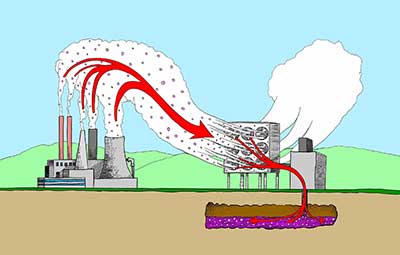Relevance: GS-3: Conservation, Environmental pollution and degradation, Environmental impact assessment
Key phrases: CCS( Carbon Capture and Storage) , CCUS( Carbon Capture Utilization and Storage) , Sedimentary rock formations, IPCC Sixth report, Principles of Equity and Climate Justice, National Programme on CO2 Storage Research
Why in News?
- In its recent Sixth Report, IPCC has asserted that Carbon Capture and Storage (CCS) has great potential to offset the rising temperature and global warming.
What is Carbon Capture?
- Carbon Capture is the long-term storage of carbon in plants, soils, geologic formations, and the ocean, can occur both naturally or as a result of anthropogenic activities.
How does Carbon Capture and Storage work?
There are essentially two ways of doing Carbon Capture And Storage, or CCS.
- Technology-based solutions
- It entails putting up machinery to capture fumes (such as from factories, large engines, etc) and removing carbon dioxide from them. The next step is, to figure out a way of disposing of the carbon dioxide.
- The most basic way to do this is to bury the gas underground — in pores of sedimentary rock formations, or in dead oilfields, that is, in sands that once held oil or gas, or in underground coal seams.
- This works if you don’t have to transport the carbon dioxide over large distances to the burial ground. The captured carbon dioxide could be injected into living oil and gas wells so as to push out the hydrocarbons.
- Scientists have also suggested that the carbon dioxide could also be injected into gas hydrates (frozen gas-water mixture), whereupon the carbon dioxide will push out the gas in the hydrate and take its place
- Nature-based solutions
- They do not ‘capture’ carbon dioxide but offset the emissions by sucking up the gas from the atmosphere — essentially involve growing trees.
- Wetland and Mangroves are said to have an enormous potential to suck up carbon dioxide.
Current status of Carbon Capture and Storage
- In 2019 (the pre-pandemic year), the world emitted 36.7 billion tonnes of carbon dioxide. Today, CCS projects are negligible in comparison with the emissions.
- The earliest CCS projects are believed to be Sleipner and Snovhit projects in Norway, which have captured and sequestered about 24 million tonnes of carbon dioxide in their 23 years of operations.
- In 2014, the Boundary Dam project in Canada was built to capture and bury around six million tonnes of carbon dioxide a year
- According to the Global CCS Institute as of 2018, there were 43 large-scale facilities — 18 in commercial operation, five under construction and 20 in various stages of development.
Limitations with Carbon Capture Storage
- Installation of CCS is costly.
- The CCS in a thermal power project, itself would take away between 6 percent and 10 percent of the power generation.
- There are issues with capital and maintenance costs.
- Carbon which is stored deep underground. Due to any tectonic activities or by rock fissures, gas may again leak to atmosphere
India status on Carbon Capture and Storage
- The government’s plans are more in the realm of ‘nature-based solutions’.
- It is very difficult to see technology CCS coming up in India, unless financially supported by the developed countries.
- National Programme on CO2 Storage Research by Department of Science and Technology
- India is part of the accelerating CCS technologies(ACT) initiative. ACT is an international initiative of 16 countries to facilitate the emergence of Carbon Capture, Usage and Storage (CCUS) via transnational funding of projects aimed at accelerating and maturing CCUS technology through targeted innovation and research activities.
- ‘Industry Charter’ for near zero emissions by 2050 was agreed to by six Indian companies that will explore different decarbonisation measures including carbon Storage.
Conclusion:
- Carbon Capture is a viable option for global leaders to achieve Net zero emission by 2050 as asserted in IPCC report, to protect the planet from rising temperature greater than 2°C. The need is a serious global co-operation and co-ordination for feasible technology development and affordable access to all, based on principles of Equity and Climate Justice.
Mains Question
Q. In its sixth report, IPCC has asserted that Carbon Capture and Storage(CCS) has great potential to offset the rising temperature and global warming. In the light of the above statement, enumerate the various ways in which carbon can be captured and stored. And, also analyse the associated challenges in the CCS technologies, and suggest some measures for successful adoption of CCS model for net zero emission by 2050. (15 marks)
Source: The Hindu BL









